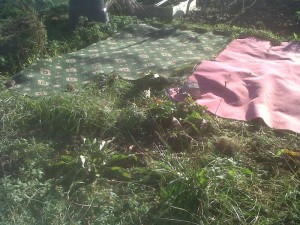 When you take over a new allotment it is more than likely going to be at least knee deep in weeds or worse. Only the very, very lucky find a nicely presented plot that is ready for planting. Please expect quite a lot of work in clearing the allotment but it will be worthwhile in the long run. Many allotment societies will also give you a discount on your first year if you are taking over a heavily weeded allotment.
When you take over a new allotment it is more than likely going to be at least knee deep in weeds or worse. Only the very, very lucky find a nicely presented plot that is ready for planting. Please expect quite a lot of work in clearing the allotment but it will be worthwhile in the long run. Many allotment societies will also give you a discount on your first year if you are taking over a heavily weeded allotment.
When our allotments opened the plots were covered with weeds and many of us ended up hiring a local farmer to plough over the plots. The real problem came from the very stony soil; there were bricks, building rubble and large stones in the soil, all of which needed removing before planting began.
Tackling the weeds can be a daunting challenge and it can be very off-putting for you. Depending on your personality type you may want to tackle the whole lot of just work on a section at a time.
You may be tempted to hire a Rotavator, which can be a big time saver. The real problem with one of these is that they chop the pernicious weeds up into little pieces and spread them over your allotment. So instead of having one dandelion you end up with the roots scattered all over and lots of dandelions will grow from them. However, they are worthwhile using if you are then going to clear the allotment properly. Some people will remove weeds like dandelions and thistles by hand before using the Rotavator in order to avoid this problem.
A good technique is to cover your plot with thick black plastic, cardboard or old carpet. This will suppress the weeds and make it easier to manage, though remember to weigh it down with bricks so that it does not blow away. Plastic is the best material to use as it does not degrade and is re-usable, but it will have to spend money to buy it!
Cardboard is a good material and you are likely able to get this free from a shop near you. This will break down after a year in to the soil and will cause no damage or problems. Carpet you can get free from a carpet fitters as they will be happy to give you old carpets they have lifted from houses. However, carpet will last for about a year before it starts being absorbed into the soil and weeds growing though it, which is problematical. Carpet is not very good for your soil and does not break down very well so if you are using it then you need to clear the area before the carpet starts going funny.
My personal approach has been to clear an area, plant it and then move on to the next area. It appeals to my mindset and the time I have available, plus it means I am getting results. Once an area is clear it gets tackled with a hoe two or three times a week to keep the weeds down. This is really important as otherwise the weeds will take over and you will be right back at the beginning.
When you are clearing an area you need to dig a good spade’s depth down and turn the soil. Break up the lump of soil, carefully avoiding damaging any dandelion/thistle/dock roots, and remove all the weeds and stones. The weeds can be composted and the stones disposed of. With large tap roots you will want to dispose of them rather than compost them as in most compost heaps they will not break down enough to stop them from rooting when the compost is used.
With grass, clover and groundsel you can remove the roots from the soil and then dig the weed in. It will break down and provide some nutrients for your soil.
If your allotment has brambles or nettles then you will need to dig out the roots and dispose of them. The nettles can be used to make nettle tea but the brambles are worth disposing of rather than composting.
You may be tempted to use a weed killer on your allotment though you are best not to. A weed killer will effect the plants you are growing, though if you are not planning on planting for some time you can probably get away with it as the chemicals will have gone by the time you plant (but the weeds may come back). Check your allotment society rules though as many do not permit the use of chemicals so you may have to go organic. You can make your own weed killer and use that if you prefer.
Once the ground is broken up and the weeds removed then you can dig in some fertilizer. A well rotted manure (horse or chicken is great) or other compost will be perfect and will ensure the soil is full of nutrients. In all likelihood the soil is going to be good because it hasn’t been grown in, but it is worth ensuring it has plenty of food for your plants.
When your allotment is dug over you are then ready to plant. Just make sure you take the time two or three times a week to hoe your allotment to keep the weeds down. It ensures the whole plot stays manageable and that the weeds do not crowd out your plants.
























Speak Your Mind